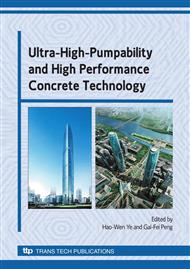[1]
Broomfield JP. Corrosion of steel in concrete: understanding, investigation and repair. UK: E&FN SPON: (1997).
Google Scholar
[2]
L. Bertolini, B. Elsener, P. Pedeferri, R. Polder Corrosion of Steel in Concrete-Prevention, Diagnosis, Repair, Wiley VCH, (2004).
DOI: 10.1002/3527603379
Google Scholar
[3]
Yu Pusong, Li Yuansong, Guo Fanzhao. Factors affecting corrosion and approaches for improving durability of ocean reinforced concrete structures. Ocean Engineering, 2004, 31: 779-789.
DOI: 10.1016/j.oceaneng.2003.07.006
Google Scholar
[4]
Economics of Corrosion (1994). NACE International Publication 3C194. Report prepared by the NACE International Task Group T-3C-1 on Industrial Economic Calculational Techniques, Unit on Economics of Corrosion, September (1994).
Google Scholar
[5]
Tahir Gonen, Salih Yazicioglu. The influence of mineral admixtures on the short and long-term performance of concrete. Building and Environment, 2007, 42 (1): 3080-3085.
DOI: 10.1016/j.buildenv.2006.10.019
Google Scholar
[6]
Khan MI, Lynsdale C J. Strength, permeability, and carbonation of high-performance concrete. Cem. Concr. Res. 2002, 32(1): 123-131.
DOI: 10.1016/s0008-8846(01)00641-x
Google Scholar
[7]
Use of Fly Ash in Concrete. ACI Manual of Concrete Practice 2001. Reported by ACI Committee 232, ACI 232. 2R-96.
Google Scholar
[8]
Shuangzhen Wang, Emilio Llamazos, Larry Baxter, Fernando Fonseca. Durability of biomass fly ash concrete: Freezing and thawing and rapid chloride permeability tests. 2008, Fuel, 87 (3): 359-364.
DOI: 10.1016/j.fuel.2007.05.027
Google Scholar
[9]
Al-Amoudi OSB, Maslehuddin M, Bader MA. Characteristics of silica fume and its impact on concrete in the Arabian Gulf. The Sixth International Conference on Deterioration and Repair of Reinforced Concrete, 2000: 80-165.
Google Scholar
[10]
WANG Dongmin, ZUO Yanfeng. Chloride Ions Diffusion Properties in High Performance Concrete with Different Materials. Journal of the Chinese Ceramic Society, 2004, 32: 1345-1361.
Google Scholar
[11]
GAO Xiaojian, BA Hengjing. Effect of mineral admixture on early age cracking. Journal of Architecture and Civil Engineering, 2006, 23: 19-20.
Google Scholar
[12]
Wang Yingfei, Huang Yanfei. Experimental Study on Cracking Sensitivity of Hardened Cement-based Paste at Early Age. Materials Journal of the Chinese Ceramic Society, 2006, 5: 44-46.
Google Scholar
[13]
A. Garcı́a Santos, J. Ma. Rincón, M. Romero, R. Talero. Characterization of a polypropylene fibered cement composite using ESEM, FESEM and mechanical testing. Construction and Building Materials, 2005, 19: 396-403.
DOI: 10.1016/j.conbuildmat.2004.07.023
Google Scholar
[14]
Nemkumar Banthia, Rishi Gupta. Influence of polypropylene fiber geometry on plastic shrinkage cracking in concrete. Cem. Concr. Res. 2006, 36 (8): 1263-1267.
DOI: 10.1016/j.cemconres.2006.01.010
Google Scholar
[15]
Houssam A. Toutanji. Properties of polypropylene fiber reinforced silica fume expansive-cement concrete. Construction and Building Materials, 1999: 171-177.
DOI: 10.1016/s0950-0618(99)00027-6
Google Scholar
[16]
NT BUILD 492: Concrete, Mortar and Cement-Based Repair U DC Materials: Chloride Migration Coefficient from non-Steady-State Migration Experiments. 691. 32/691. 53/691. 54.
Google Scholar


